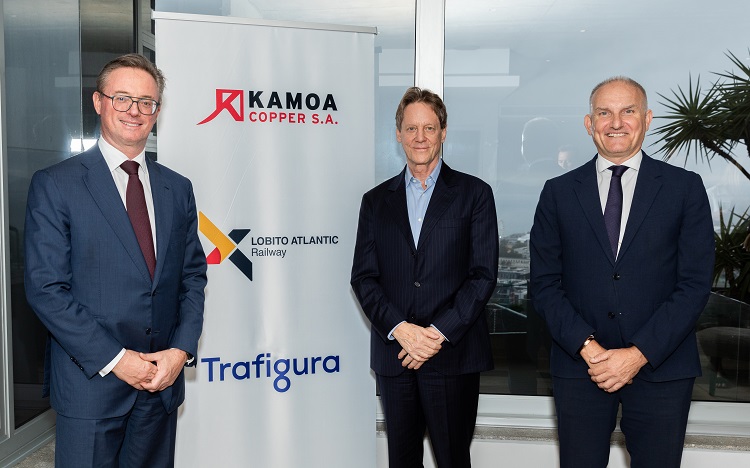Trafigura and Kamoa-Kakula have today agreed long-term commitments to transport minerals via the Lobito Atlantic Railway for a minimum term of six years. The terms of the Reserved Capacity Agreements were signed during the Mining Indaba in Cape Town, South Africa and mark the first long-term commercial commitments to the Lobito Atlantic Railway, a new import-export trade route between the African Copperbelt and Angola’s Atlantic coast.
The Lobito Atlantic Railway is expected to ramp up to an annual export capacity of one million tonnes per annum before the end of the decade. Trafigura’s allocation of export capacity on the Lobito Atlantic Railway will be up to 450,000 tonnes per annum from 2025. In addition, the Kamoa-Kakula copper complex, a joint venture between Ivanhoe Mines and Zijin Mining, has been allocated a minimum capacity of 120,000 tonnes and up to 240,000 tonnes per annum of copper products – blister-anode or concentrate – from 2025, with an initial commitment of 10,000 tonnes to be transported in 2024 as the railway ramps up.
In 2022, the Lobito Atlantic Railway consortium, comprising Trafigura, Mota-Engil and Vecturis, was awarded a 30-year concession for the operation, management and maintenance of the Lobito Atlantic Railway (LAR) and for the Lobito Minerals port. The upgraded line will provide a more efficient and lower-carbon route to market for copper, cobalt and other metals crucial to the energy transition and will operate on the basis of open commercial access.
Jeremy Weir, Executive Chairman and CEO of Trafigura commented:
“We are pleased to be one of the first commercial customers to agree terms for a long-term commitment to use the Lobito Atlantic Railway and we look forward to welcoming other customers to join Ivanhoe Mines and Trafigura in the coming months.
“These commitments announced today support the consortium’s aim to grow the volumes on the corridor so that it becomes the leading rail transport link in sub-Saharan Africa.”
Ivanhoe Mines’ Founder and Executive Co-Chairman, Robert Friedland commented:
“We admire the hard work of the Lobito Corridor consortium and Trafigura, working with their partners in the Democratic Republic of the Congo and Angola, to build a new supply chain that is fast becoming one of the most important trade routes for vital copper metal in the world.
“The transformative economic corridor will unlock more copper projects due to the lower logistical costs. Cheaper logistics increase the amount of economically recoverable copper across the Copperbelt, as cut-off grades can be lowered. This makes a significant impact on discoveries made in the DRC, such as the recent high-grade and open-ended Kitoko copper discovery in the Western Foreland, where we are stepping up exploration activities this year to find more ultra-green copper metal. Kitoko is located only 30 kilometres from the existing rail line.”
The project to refurbish the Lobito Atlantic Corridor benefits from the support of the governments of Angola, DRC, Zambia and the U.S. government’s Partnership for Global Infrastructure Investment (PGII). The project represents an investment of more than USD500 million over the lifetime of the concession, with a potential financing of at least USD250 million from the U.S. International Development Finance Corporation. The investment will enable the renovation of sections of the railway line and associated infrastructure, in addition to securing more than 1,500 wagons and 35 locomotives.
During Mining Indaba this week (from left to right) Jeremy Weir, Executive Chairman and CEO, Trafigura; Robert Friedland, Founder and Executive Co-Chairman, Ivanhoe Mines and Francisco Franca, CEO, Lobito Atlantic Railway.



